1998 HONDA ODYSSEY lock
[x] Cancel search: lockPage 4 of 272

Driver and Passenger Safety
This section gives you important information about how to protect
yourself and your passengers. It
shows you how to use seat belts
properly. It explains your Supple-
mental Restraint System. And it tells
you how to properly restrain infants
and children in your vehicle.
Important Safety Precautions .......... 4
Your Vehicle's Safety Features........ 5
Seat Belts........................................ 6
Airbags............................................ 7
Seats & Seat-Backs........................ 8
Head Restraints............................. 8
Door Locks..................................... 9
Pre-Drive Safety Checklist........... 9
Protecting Adults............................. 10 1. Close and Lock the Doors...... 10
2. Adjust the Front Seats............ 10
3. Adjust the Seat-Backs............. 11
4. Adjust the Head Restraints.... 12
5. Fasten and Position the Seat
Belts...................................... 13
6. Adjust the Steering Wheel..... 16
7. Maintain a Proper Sitting
Position................................. 16
Advice for Pregnant Women...... 17
Additional Safety Precautions.... 17
Protecting Children......................... 19
All Children Must Be Restrained................................ 19
Children Should Sit in the Back
Seat............................................ 20
The Passenger's Airbag Poses Serious Risks to Children....... 20
If You Must Drive with Several Children.................................... 21 If a Child Requires Close
Attention................................... 22
Additional Safety Precautions.... 22
General Guidelines for Using
Child Seats................................ 23
Protecting Infants........................ 27
Protecting Small Children.......... 31
Protecting Larger Children........ 35 Using Child Seats with Tethers...................................... 38
Additional Information About Your Seat Belts.................................. 41
Seat Belt System Components... 41
Lap/Shoulder Belt....................... 41
Lap Belt......................................... 42
Seat Belt Maintenance................ 42
Additional Information About Your
SRS........................................... 44
SRS Components......................... 44
How Your Airbags Work............ 44
How Your SRS Indicator Light
Works........................................ 45
SRS Service................................... 46
Additional Safety Precautions.... 46
Carbon Monoxide Hazard.............. 47
Safety Labels.................................... 48
Driver and Passenger SafetyProCarManuals.comMain Menu s t
Page 6 of 272
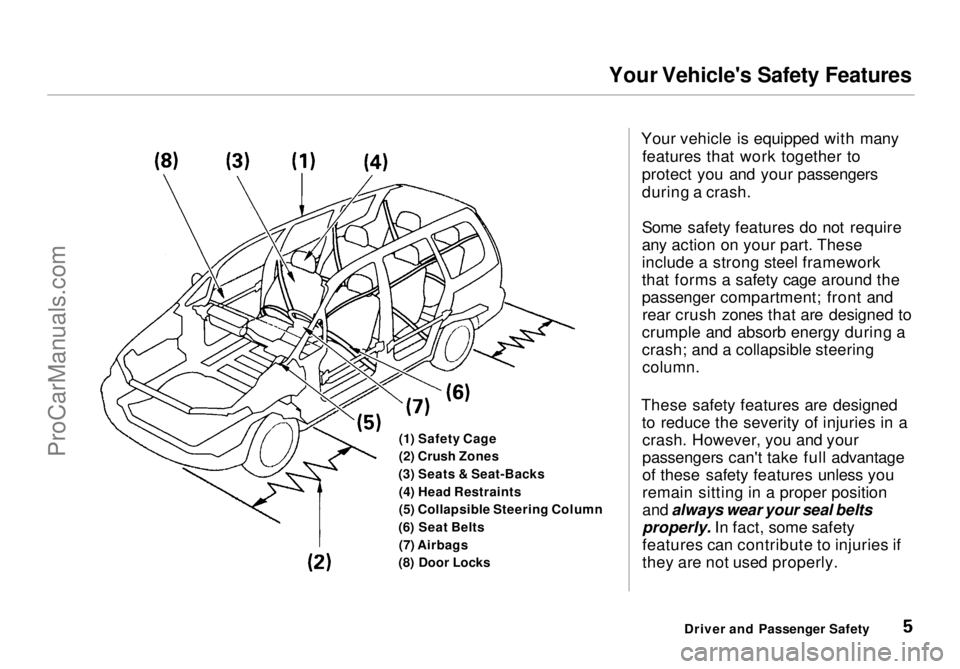
Your Vehicle's Safety Features
(1) Safety Cage
(2) Crush Zones
(3) Seats & Seat-Backs (4) Head Restraints
(5) Collapsible Steering Column
(6) Seat Belts (7) Airbags
(8) Door Locks Your vehicle is equipped with many
features that work together to
protect you and your passengers
during a crash.
Some safety features do not require
any action on your part. These
include a strong steel framework
that forms a safety cage around the
passenger compartment; front and rear crush zones that are designed to
crumple and absorb energy during a
crash; and a collapsible steering
column.
These safety features are designed to reduce the severity of injuries in acrash. However, you and your
passengers can't take full advantage
of these safety features unless you
remain sitting in a proper position
and always wear your seal belts
properly. In fact, some safety
features can contribute to injuries if
they are not used properly.
Driver and Passenger SafetyProCarManuals.comMain Menu Table of Contents s t
Page 10 of 272

Your Vehicle's Safety Features
Door Locks
Keeping your doors locked reduces
the chance of being thrown out of
the vehicle during a crash. It also
helps prevent occupants from accidentally opening a door and
falling out, and outsiders from unexpectedly opening your doors.
Pre-Drive Safety Checklist
To make sure you and your passengers get the maximum
protection from your vehicle's safety
features, check the following each
time before you drive away: All adults, and children who have
outgrown child safety seats, are
wearing their seat belts and
wearing them properly (see page
13).
Any infant or small child is
properly restrained in a child seat
in a back seat (see page 19 ). Front seat occupants are sitting as
far back as possible from the steering wheel and dashboard (see page 10). Seat-backs are upright (see page
11).
Head restraints are properly
adjusted (see page 12 ). All doors and the tailgate are
closed and locked (see page 10). All cargo is properly stored or
secured (see page 136).
The rest of this section gives more detailed information about how you
can maximize your safety.
Remember, however, that no safety system can prevent all injuries ordeaths that can occur in severe
crashes, even when seat belts are
properly worn and the airbags deploy.
Driver and Passenger SafetyProCarManuals.comMain Menu Table of Contents s t
Page 11 of 272
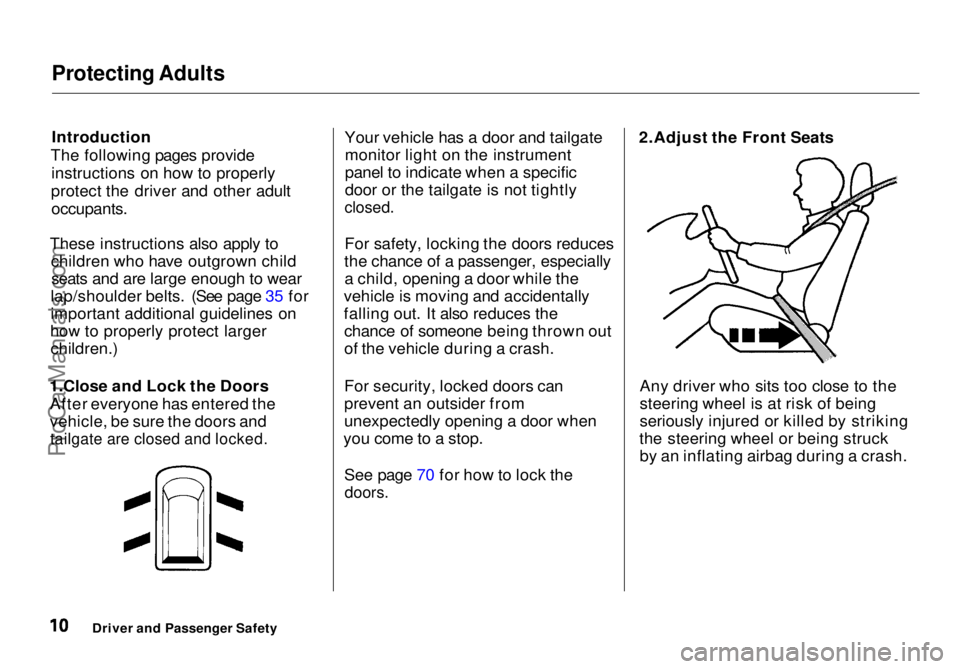
Protecting Adults
Introduction
The following pages provide instructions on how to properly
protect the driver and other adult
occupants.
These instructions also apply to children who have outgrown childseats and are large enough to wear
lap/shoulder belts. (See page 35 for
important additional guidelines on
how to properly protect larger children.)
1.Close and Lock the Doors After everyone has entered the
vehicle, be sure the doors and
tailgate are closed and locked.
Your vehicle has a door and tailgate
monitor light on the instrument
panel to indicate when a specific
door or the tailgate is not tightly
closed.
For safety, locking the doors reduces
the chance of a passenger, especially a child, opening a door while the
vehicle is moving and accidentally
falling out. It also reduces the chance of someone being thrown out
of the vehicle during a crash.
For security, locked doors can
prevent an outsider from
unexpectedly opening a door when
you come to a stop.
See page 70 for how to lock the
doors.
2.Adjust the Front Seats
Any driver who sits too close to thesteering wheel is at risk of being
seriously injured or killed by striking
the steering wheel or being struck by an inflating airbag during a crash.
Driver and Passenger SafetyProCarManuals.comMain Menu Table of Contents s t
Page 12 of 272
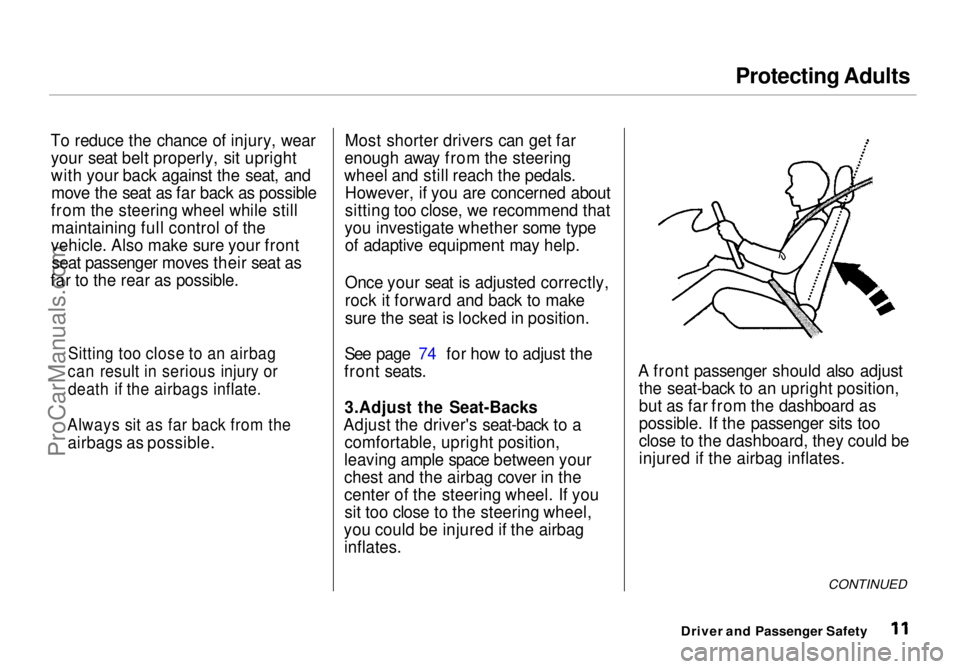
Protecting Adults
To reduce the chance of injury, wear your seat belt properly, sit upright
with your back against the seat, andmove the seat as far back as possible
from the steering wheel while still maintaining full control of the
vehicle. Also make sure your front seat passenger moves their seat as
far to the rear as possible. Most shorter drivers can get far
enough away from the steering
wheel and still reach the pedals. However, if you are concerned about
sitting too close, we recommend that
you investigate whether some type of adaptive equipment may help.
Once your seat is adjusted correctly,
rock it forward and back to make
sure the seat is locked in position.
See page 74 for how to adjust the
front seats.
3.Adjust the Seat-Backs
Adjust the driver's seat-back to a comfortable, upright position,
leaving ample space between your
chest and the airbag cover in the
center of the steering wheel. If you sit too close to the steering wheel,
you could be injured if the airbag inflates. A front passenger should also adjust
the seat-back to an upright position,
but as far from the dashboard as
possible. If the passenger sits too
close to the dashboard, they could be
injured if the airbag inflates.
CONTINUED
Driver and Passenger Safety
Sitting too close to an airbag
can result in serious injury or
death if the airbags inflate.
Always sit as far back from the
airbags as possible.ProCarManuals.comMain Menu Table of Contents s t
Page 18 of 272
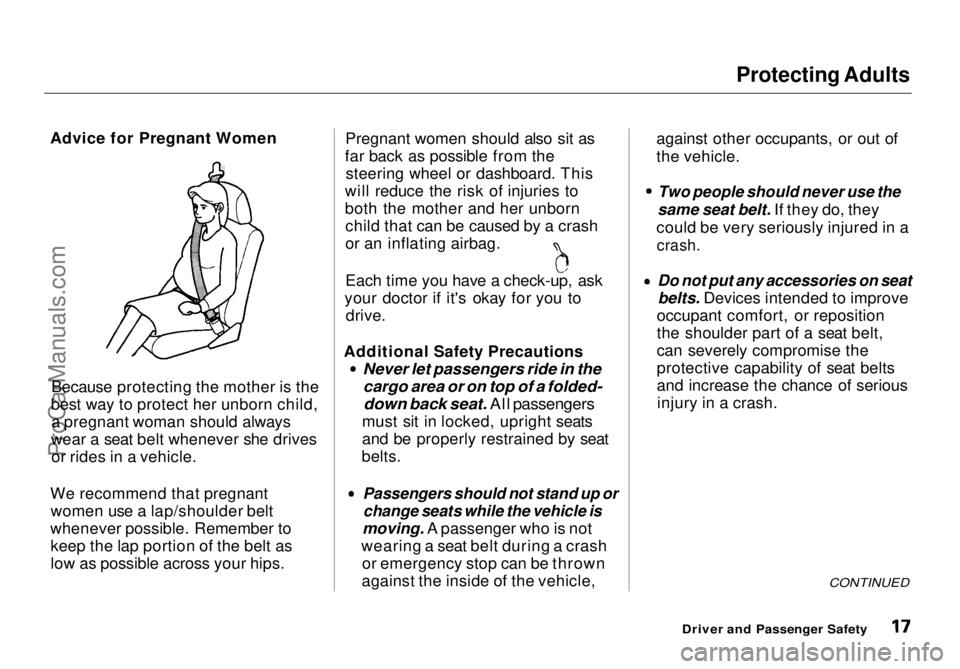
Protecting Adults
Advice for Pregnant Women
Because protecting the mother is the
best way to protect her unborn child, a pregnant woman should always
wear a seat belt whenever she drives or rides in a vehicle.
We recommend that pregnant women use a lap/shoulder belt
whenever possible. Remember to keep the lap portion of the belt as
low as possible across your hips. Pregnant women should also sit as
far back as possible from the steering wheel or dashboard. This
will reduce the risk of injuries to
both the mother and her unborn child that can be caused by a crash
or an inflating airbag. Each time you have a check-up, ask
your doctor if it's okay for you to drive.
Additional Safety Precautions
Never let passengers ride in the
cargo area or on top of a folded-
down back seat. All passengers
must sit in locked, upright seats
and be properly restrained by seat
belts.
Passengers should not stand up or
change seats while the vehicle is
moving. A passenger who is not
wearing a seat belt during a crash or emergency stop can be thrown
against the inside of the vehicle, against other occupants, or out of
the vehicle.
Two people should never use the
same seat belt. If they do, they
could be very seriously injured in a
crash.
Do not put any accessories on seat
belts. Devices intended to improve
occupant comfort, or reposition
the shoulder part of a seat belt,
can severely compromise the
protective capability of seat belts
and increase the chance of serious injury in a crash.
CONTINUED
Driver and Passenger SafetyProCarManuals.comMain Menu Table of Contents s t
Page 23 of 272

Protecting Children
If a Child Requires Close
Attention
Many parents say they prefer to put
an infant or small child in the front
passenger seat so they can watch the child, or because the child requires
attention.
Placing a child in the front seat
exposes them to hazards from the
airbag, and paying close attention to
a child distracts the driver from the
important tasks of driving, creating serious safety risks.
If a child requires physical attention
or frequent visual contact, westrongly recommend that another
adult ride with the child in a back seat. A back seat is far safer for a
child than the front. Additional Safety Precautions
Use childproof door locks to
prevent children from opening the
doors. Using this feature will
prevent children from opening the doors and accidentally falling out (see page 72 ).
Use the main power window
switch to prevent children from opening the rear windows. Using
this feature will prevent children
from playing with the windows,
which could expose them to
hazards or distract the driver (see
page 82 ). Do not leave children alone in your
vehicle. Leaving children without
adult supervision is illegal in most states and can be very hazardous.
For example, infants and small
children left in a vehicle on a hot day can die from heatstroke. And
children left alone with the key in
the ignition can accidentally set
the vehicle in motion, possibly
injuring themselves or others.
Driver and Passenger SafetyProCarManuals.comMain Menu Table of Contents s t
Page 29 of 272
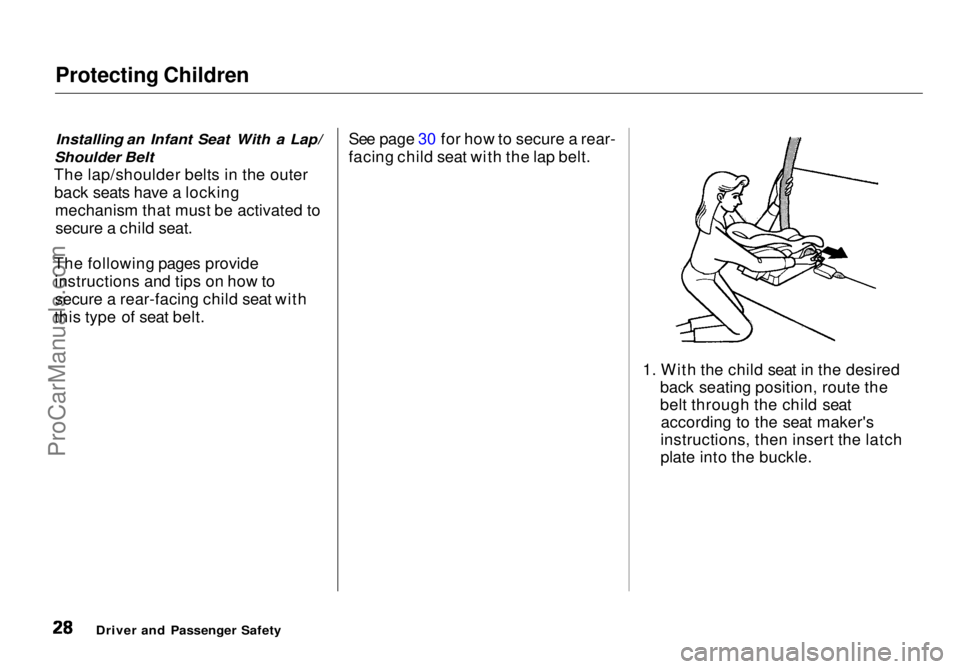
Protecting Children
Installing an Infant Seat With a Lap/
Shoulder Belt
The lap/shoulder belts in the outer back seats have a locking mechanism that must be activated tosecure a child seat.
The following pages provide instructions and tips on how tosecure a rear-facing child seat with
this type of seat belt. See page 30 for how to secure a rear-
facing child seat with the lap belt.
1. With the child seat in the desiredback seating position, route the
belt through the child seataccording to the seat maker's
instructions, then insert the latch
plate into the buckle.
Driver and Passenger SafetyProCarManuals.comMain Menu Table of Contents s t